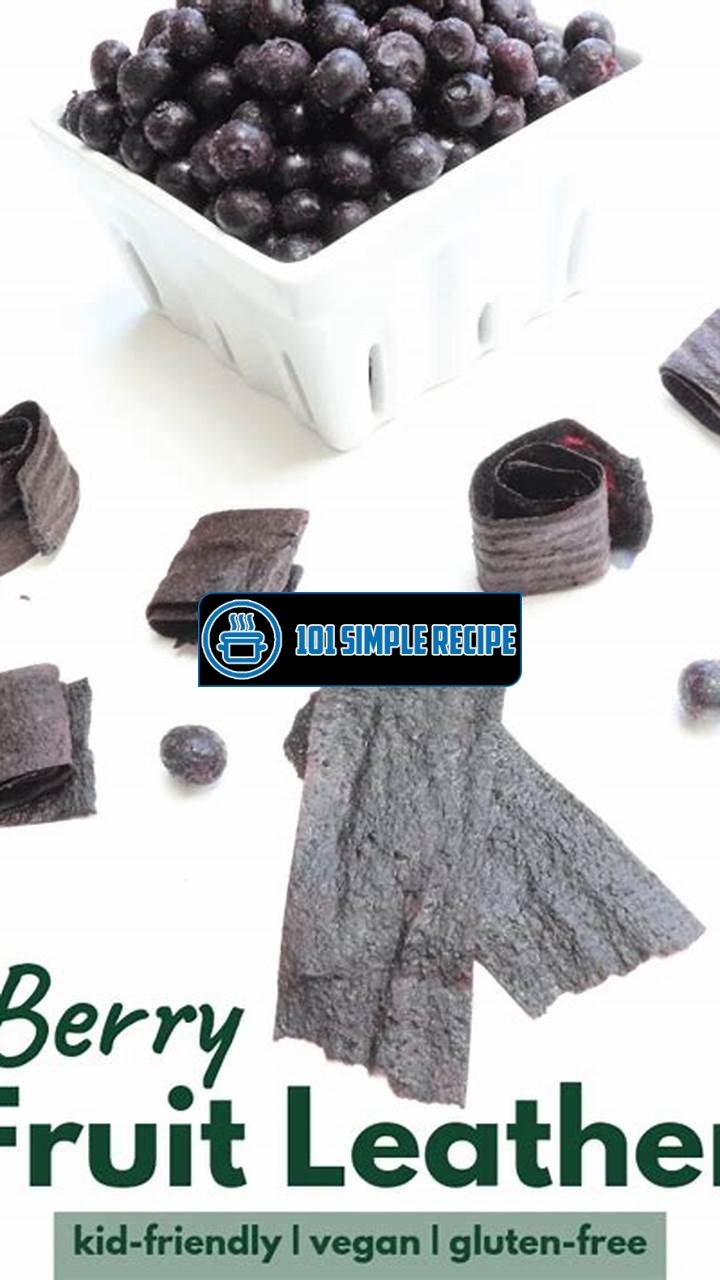Looking to make delicious and nutritious fruit leather but don’t have a fancy dehydrator? Well, you’re in luck! In this article, we will guide you through the process of making fruit leather without a dehydrator, using just your oven. So, get your apron ready and let’s dive into this homemade fruit leather adventure! But before we get started, take a look at this mouthwatering image of homemade fruit leather to get you even more excited!

Understanding the Fruit Leather Making Process
When it comes to making delicious and healthy fruit leather, you may think that a dehydrator is essential. However, did you know that you can make fruit leather without a dehydrator? In this article, we will explore the process of making fruit leather using alternative methods and tools, allowing you to enjoy this tasty treat even if you don’t have a dehydrator.
Using the Oven to Make Fruit Leather
Making fruit leather in the oven is a popular method that has been used for many years. The process involves pureeing fresh fruits and spreading the mixture thinly onto a baking sheet. Then, it is placed in the oven at a low temperature for several hours to remove the moisture and create the desired texture.
To make fruit leather in the oven, start by preheating your oven to the lowest temperature setting. While some ovens have a specific temperature setting for dehydrating, setting it around 140°F (60°C) will work just fine. Next, prepare your fruit by washing, peeling, and removing any seeds or pits. Puree the fruit in a blender or food processor until smooth.
Once you have your fruit puree ready, line a baking sheet with parchment paper or a silicone baking mat. Pour the puree onto the sheet, spreading it evenly with a spatula or the back of a spoon. Make sure the layer is thin and uniform, around 1/8 to 1/4 inch thick.
Now, place the baking sheet with the fruit puree into the preheated oven. Leave the oven slightly cracked open to allow moisture to escape. This will help the fruit leather dry properly. Let it bake for several hours, checking periodically until the fruit leather is no longer sticky and has a leathery texture.
Creating Fruit Leather with a Sun-Drying Method
If you prefer a more natural approach, making fruit leather using the sun-drying method is an excellent option. This method takes advantage of the sun’s heat and airflow to dehydrate the fruit puree and create tasty fruit leather.
To make fruit leather using the sun-drying method, start by preparing your fruit just as you would for the oven method. Puree the fruit until smooth and then spread it thinly onto a baking sheet or a food-grade drying rack. Place the sheet or rack in a sunny and well-ventilated area, ensuring it is protected from any pests or debris.
The sun-drying method requires warm and dry weather, so it is best to attempt this during the summer months. Make sure to check the weather forecast as rain or high humidity can interfere with the drying process. Leave the fruit puree to dry in the sun for several days, turning it occasionally to ensure even drying.
Exploring Other Alternative Methods
In addition to the oven and sun-drying methods, there are other alternative methods you can explore to make fruit leather without a dehydrator. Some options include using a microwave, a portable dehydrator, or even a DIY dehydrator made from household items. These alternative methods may require different steps and techniques, so it’s essential to follow specific instructions for each.
Now that you understand the process of making fruit leather without a dehydrator, you can enjoy this delicious and wholesome snack anytime. Whether you choose to use the oven, the sun, or try other alternative methods, you’ll be able to create homemade fruit leather that’s bursting with natural flavor and goodness.
Choosing the Right Fruits for Fruit Leather
When it comes to making delicious and healthy fruit leather without a dehydrator, selecting the right fruits is key. By choosing the right fruits, you can ensure that your fruit leather turns out tasty, flavorful, and packed with nutrients. Let’s explore the different factors to consider when selecting fruits for your homemade fruit leather.
Selecting Fruits with High Water Content
One important factor to consider when choosing fruits for fruit leather is their water content. Fruits that have a high water content are ideal for making fruit leather. These fruits will not only provide the necessary moisture for the fruit leather, but they will also enhance the texture and make it easier to blend into a smooth puree.
Some fruits that are known for their high water content include watermelon, strawberries, grapes, and oranges. Watermelons, in particular, are an excellent choice due to their juicy nature and sweet taste.
By choosing fruits with high water content, you are ensuring that your fruit leather will have a moist and chewy texture, which is exactly what you want in this tasty treat.
Choosing Sweet and Flavorful Fruits
In addition to water content, the sweetness and flavor of the fruits you choose are crucial for creating delicious fruit leather. Fruits with natural sweetness will make your fruit leather more enjoyable to eat without the need for added sugars. Plus, they will infuse your fruit leather with a burst of flavor.
Strawberries, raspberries, and mangoes are great examples of fruits that are both sweet and flavorful. These fruits are packed with natural sugars that will make your fruit leather taste absolutely delightful.
By opting for sweet and flavorful fruits, you can enhance the taste of your fruit leather while keeping it wholesome and nutritious.
Considering Texture and Consistency
Texture and consistency also play a role in creating the perfect fruit leather. Some fruits have a soft and mushy texture once blended, while others are more fibrous and have a chunkier consistency. It’s important to consider these factors when selecting fruits for your homemade fruit leather.
Fruits like bananas and avocados have a creamy and smooth consistency when pureed, making them excellent choices for creating a velvety fruit leather. However, fruits like apples and pears have a more fibrous texture, which can add an interesting element to your fruit leather.
By considering the texture and consistency of the fruits you choose, you can create fruit leather with a variety of mouthfeel experiences, making each bite a delightful surprise!
Choosing the right fruits for fruit leather is essential for achieving the perfect balance of flavor, texture, and moisture. By selecting fruits with high water content, natural sweetness, and the desired texture, you can create delicious and healthy fruit leather without a dehydrator. So go ahead and get creative with your fruit selections, and enjoy the fruits of your labor in the form of scrumptious homemade fruit leather!
If you’re looking for an easy and tasty snack, check out this recipe for banana leather without a dehydrator.
Preparing the Fruits for Fruit Leather
Before you can turn your fresh fruits into delicious fruit leather, it is important to follow a few necessary steps to prepare them. By properly washing and cleaning the fruits, removing seeds, cores, and peels, and blending or pureeing them, you can ensure that your fruit leather turns out tasty and mouthwatering. Let’s dive into each step and explore them in detail:
Washing and Cleaning the Fruits
The first and foremost step is to wash and clean the fruits thoroughly. This is essential to remove any dirt, bacteria, or pesticides that may be present on the surface. Start by rinsing the fruits under cool running water. Use your hands to gently rub the fruits to remove any dirt or residue. For firmer fruits like apples or pears, you can also use a brush to scrub the surface. Make sure to dry the fruits completely using a clean towel before proceeding to the next step.
Removing Seeds, Cores, and Peels
Once the fruits are clean, the next step is to remove any seeds, cores, or peels that are not desired in the fruit leather. This step will depend on the type of fruit you are using. For fruits such as berries or grapes, you can skip this step as they typically do not have seeds or peels that need to be removed. However, for fruits like apples, peaches, or kiwis, you will need to take some extra time to ensure they are properly prepared.
To remove seeds, simply cut the fruit in half and use a spoon or knife to scoop out the seeds. For cores, carefully slice around the core to remove it from the fruit. For peels, use a peeler or a sharp knife to remove the skin. It is important to note that some fruits, like apples, may oxidize and turn brown when exposed to air. To prevent this, you can soak the peeled fruit in a mixture of lemon juice and water before proceeding to the next step.
Blending or Pureeing the Fruits
After the fruits have been washed, cleaned, and prepared, it’s time to blend or puree them. This step is crucial to create a smooth and consistent texture for your fruit leather. You can use a blender, food processor, or immersion blender to achieve the desired consistency. Make sure to blend the fruits until they are completely smooth, with no chunks or lumps remaining. If needed, you can add a small amount of water or fruit juice to help with the blending process.
When blending the fruits, it is important to consider the flavor combinations. You can mix different fruits together to create unique and delicious fruit leather flavors. Be creative and experiment with different combinations to find your favorite blend. Remember, the more flavorful the fruits, the tastier your fruit leather will be!
Once the fruits are blended or pureed, you can proceed to the next steps of making fruit leather, such as spreading the puree onto a baking sheet or using a dehydrator. These steps will not be covered in this article, but now you have the necessary knowledge to prepare your fruits for fruit leather without a dehydrator. Enjoy the process and savor the delicious results!
Sweetening and Flavoring the Fruit Leather
When it comes to making fruit leather without a dehydrator, one of the most important aspects to consider is how to sweeten and flavor it. By using various natural sweeteners and flavorings, you can enhance the taste and make your homemade fruit leather even more enjoyable.
Using Honey, Maple Syrup, or Agave Nectar as Sweeteners
One popular option for sweetening fruit leather is to use natural sweeteners like honey, maple syrup, or agave nectar. These alternatives to refined sugar not only add sweetness but also bring their unique flavors to the mix.
Honey, for example, has a distinct floral taste that can complement a wide variety of fruits. Its natural viscosity also helps bind the fruit mixture together, resulting in a smoother texture.
Maple syrup, on the other hand, offers a rich and caramel-like sweetness. Its deep flavor pairs exceptionally well with fruits like apple, pear, and pumpkin.
Agave nectar is another sweetener option that works great in fruit leather recipes. It has a milder taste compared to honey and maple syrup, making it ideal for those who prefer a less pronounced sweetness.
✨
Adding Spices and Extracts for Flavor
To further enhance the flavor of your fruit leather, you can incorporate a variety of spices and extracts. These aromatic additions can take your homemade treat to a whole new level.
Cinnamon, for instance, is a versatile spice that complements a wide range of fruits. Its warm and earthy notes can add depth and complexity to the overall flavor profile of your fruit leather.
Other popular spices to consider include nutmeg, cardamom, and ginger, each offering its own unique taste and aroma. Extracts like vanilla or almond can also be used to bring a subtle but delightful flavor to the mix.
️
Experimenting with Combinations for Unique Flavors
The beauty of making fruit leather without a dehydrator is that you have the freedom to experiment with different combinations of fruits, sweeteners, and flavorings. This allows you to create unique flavors that suit your personal tastes.
Consider mixing fruits of different tartness levels to achieve a well-balanced flavor. Combining sweeter fruits like strawberries or peaches with tangy ones like raspberries or cranberries can create a delightful contrast.
Don’t be afraid to think outside the box and try unconventional pairings. For example, mango and chili powder can give your fruit leather a spicy kick, while adding a touch of lavender to blueberry leather can add a soothing floral note.
Remember, the possibilities are endless, so feel free to let your creativity run wild and come up with unique fruit leather combinations that will wow your taste buds.
️
For a delicious twist, try this recipe for homemade fruit leather without a dehydrator.
Drying and Storing Fruit Leather
In order to enjoy homemade fruit leather without a dehydrator, it’s important to learn the proper techniques for drying and storing the delicious treat. These techniques will not only ensure its freshness but also its longevity, allowing you to enjoy your homemade fruit leather for weeks to come. Below are three key techniques to consider when drying and storing fruit leather.
Using Parchment Paper or Silicone Mats for Drying
When it comes to drying fruit leather without a dehydrator, using parchment paper or silicone mats is essential. This helps prevent the fruit mixture from sticking to the surface and ensures easy removal once it’s dried. To do this, simply spread a thin layer of the fruit mixture onto the parchment paper or silicone mat, making sure it’s evenly distributed. The fruit leather should be about 1/8 inch thick to ensure even drying.
Note: Using parchment paper or silicone mats makes the drying process much easier and prevents the mixture from sticking.
Monitoring Drying Time and Temperature
Properly monitoring the drying time and temperature is crucial for achieving perfectly dried homemade fruit leather. Without a dehydrator, you can dry the fruit mixture in an oven set to a low temperature, typically around 140°F (60°C). It’s important to check the fruit leather regularly to avoid over-drying, which can result in a texture that is too brittle or hard.
Note: Keep a close eye on the drying process to ensure the fruit leather is not over-dried, which can affect its texture.
Storing Fruit Leather in Airtight Containers
Once the fruit leather is fully dried, it’s time to store it properly to maintain its freshness. Airtight containers, such as glass jars or food storage bags, are ideal for storing fruit leather. Make sure to choose containers that are clean and completely dry to prevent any moisture from getting trapped and causing spoilage. Store the fruit leather in a cool, dry place to maximize its shelf life.
Note: Storing fruit leather in airtight containers helps preserve its freshness and extends its shelf life.
By following these proper techniques for drying and storing fruit leather without a dehydrator, you can enjoy your homemade treat for weeks. Whether you choose to use parchment paper or silicone mats for drying, monitor the drying time and temperature, or store it in airtight containers, you can be sure that your fruit leather will remain delicious and fresh.
Want to try something different? Give this recipe for apple leather without a dehydrator a go.
Frequently Asked Questions
Here are some frequently asked questions about making fruit leather without a dehydrator:
| No. | Questions | Answers |
|---|---|---|
| 1. | Can I make fruit leather without a dehydrator? | Yes, absolutely! You don’t need a dehydrator to make delicious fruit leather. There are alternative methods that you can use to achieve the same result. |
| 2. | What are some alternative methods to make fruit leather without a dehydrator? | You can use your oven or even the sun to dehydrate the fruit and make fruit leather. Both methods require a bit of time and patience, but they can yield great results. |
| 3. | How do I make fruit leather in the oven? | To make fruit leather in the oven, you’ll need to puree the fruit, spread it thinly on a baking sheet lined with parchment paper, and bake it at a low temperature for several hours until it becomes dry and leathery. |
| 4. | Can I make fruit leather without any added sugar? | Yes, absolutely! You can make fruit leather without any added sugar by using ripe and sweet fruits. The natural sugars in the fruit will be enough to create a delicious and healthy snack. |
| 5. | How long does it take to make fruit leather without a dehydrator? | The time it takes to make fruit leather without a dehydrator can vary depending on the method you choose and the thickness of the fruit puree. It can take anywhere from 6-12 hours. |
| 6. | How should I store homemade fruit leather? | To store homemade fruit leather, you should place it in an airtight container or wrap it in plastic wrap. Keep it in a cool, dry place away from direct sunlight. It will stay fresh for a few weeks. |
Closing Thoughts
Thank you for taking the time to read this article on how to make fruit leather without a dehydrator. By using alternative methods like the oven or the sun, you can still enjoy the delicious and healthy snack that fruit leather provides. Experiment with different fruit combinations and flavors to create your perfect homemade fruit leather. Remember to visit again later for more exciting recipes and kitchen tips. Happy fruit leather making!
Jump to Recipe
How to Make Fruit Leather without a Dehydrator

Learn how to make delicious fruit leather without a dehydrator using alternative methods like the oven or the sun. Enjoy this healthy snack at home!
- 4 cups of mixed fruits (berries, apples, mango, etc.)
- 2 tablespoons of lemon juice
- 1 tablespoon of honey or maple syrup (optional)
- Preheat your oven to 170°F (75°C). Line a baking sheet with parchment paper.
- Puree the mixed fruits in a blender or food processor until smooth. Add lemon juice and honey/maple syrup (if using) and blend again.
- Pour the fruit puree onto the prepared baking sheet and spread it evenly with a spatula.
- Place the baking sheet in the oven and bake for 6-8 hours, or until the fruit leather is dry and leathery to the touch.
- Remove the baking sheet from the oven and let the fruit leather cool completely. Once cooled, cut it into strips or desired shapes.
- Roll up the fruit leather strips and store them in an airtight container or wrap individually in plastic wrap. Keep in a cool, dry place.
- Enjoy your homemade fruit leather as a healthy snack or on-the-go treat!



